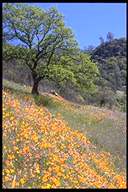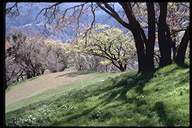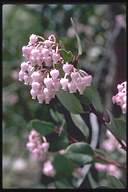
THE OAK WOODLANDS
By Julie Carville
Oak woodlands, like those of the Spenceville Wildlife Area, have sheltered and sustained humans and animals for thousands of years, and their magnificence and beauty awed the early explorers. When William Brewer first saw the huge valley oaks in 1861, while doing a plant survey near Monterey, he wrote, "I measured one with wide spreading and cragged branches, that was 26.5 feet in circumference. Another had a diameter of over 6 feet, and the branches spread over 75 feet each way. I lay beneath its shade a little while before going on." It's hard to imagine how park-like and beautiful California once was before such huge trees and vast groves were destroyed by over-cutting, grazing and land clearing, practices that still pose a serious threat to the future of California's oak.

Oak woodlands are important for their beauty, and for the many diverse species of animals that they support. Many animals from the great Central Valley and the higher Sierran elevations find temporary refuge during periods of extreme heat or cold in such mid-elevation oak woodlands, making Spenceville an important stopover area for migrating animals. Oaks with their sheltering growth provide cool shade when the summer temperatures soar and evergreen oaks protect animals in winter from snow and rain. Acorns from the oaks support deer, squirrels and other animals and birds with their high fat and nutritional content. Oak leaves attract various insect larvae, which in turn provide delicious morsels for birds. Oak riparian corridors, with their mix of deciduous trees and shrubs, are essential to daytime roosting of birds, as an escape from the heat and as a cool, shaded micro-climate for young nestlings. In addition, many bird species utilize more than one habitat type to meet their daily requirements, and the mix of plants found in oak woodlands, particularly those adjacent to quality riparian habitat, such as in Spenceville, is essential.
The dense stream-side vegetation found in these mid-range habitats supplies the streams with rich organic plant materials necessary to sustain the vast numbers of invertebrates necessary to support other forms of life. On the larger foothill streams, such as the American and Yuba Rivers, with their steeper gradients, heavy winter runoffs scour the banks of much of their riparian vegetation. Therefore small streams with gradual banks, like Spenceville's creeks, with their dense riparian vegetation offer productive food sources, cover, nesting sites and the rich abundance of insects that are associated with riparian plant species. You will find several species of oaks in Spenceville, including the deciduous Valley and Blue Oaks and the evergreen Live Oak.

Blue Oak, Quercus douglasii. Blue oaks are medium sized trees, compared to the valley oak, and are well adapted to the hot dry summers of Spenceville, growing in healthy abundance on its grassy knolls. Their leathery, bluish green leaves, are wavy edged and often shallowly lobed. The blue oak is smaller and less grand than the valley oak and seems, by its often scraggily growth, to be struggling for survival. Its leaves are 1 to 3 inches long and pale below. Its acorns, which take one year to ripen, are ¾ to 1 ½ inches long and sit in cups with small bumps. As you walk past the blue oaks, look closely at the leaves to see if you can find an amazing gall that grows on the surface, which looks like a little pinkish-red sea urchin. Galls are tumor-like growths formed on plant tissue by chemical or mechanical stimulation from an insect or other invading plant. This particular gall is created by a tiny gall wasp that inserts a nucleic acid and protein along with its eggs into the plant material. The plant reacts by forming a gall around the eggs which both protects and later feeds the developing insect. In November the adults exit from the gall to continue a complex but interesting life process.
Valley Oak, Quercus lobata The Valley Oak is among the largest of California's oaks with its broad, sweeping branches that form a protective canopy, and in older trees bend down to touch the ground in a grand gesture. The Valley Oak loses its leaves at the end of the hot summer and stands leafless all winter. Its bluntly lobed leaves are 2 to 4 inch long leaves long by about 2 inches wide, are a dull green above and a pale green below. Gently squeeze the leaves and you will be able to inhale their sweet woodsy odor. The acorns are about 1 to 2 inches long with bumpy knobs on the cups. You'll often find green to brown galls in the shape of 2 to 3 inch round balls, called oak apples, when you look among the branches. Cynipid wasps in a process similar to that discussed above form them.
Interior Live Oak, Quercus wislizenii, Since this evergreen oak does not lose its leaves in the winter, it has earned the name, live oak. It forms a broad canopy of thick branches with leathery leaves, one to three inches long, that are deep green on the upper surface and yellowish green on the underside. The margins or leaf edges vary greatly among the various leaves on the same tree and may be smooth, spiny and/or toothed. Its acorns take 2 years to mature and are about ¾ to 1 ½ long, with cups that carry thin, overlapping scales. Its leathery leaves help to reduce evaporation in the hot summers of Spenceville. It creates vast canopies of green in the dead of winter in Spenceville, forming protection for the bird species that winter here.
The oaks of Spenceville sustained generations of native people with the richness of their acorn seeds. After the acorns were shelled and ground in depressions on rock slabs, the meal was leached with water to remove the tannic acid and then cooked as a mush or baked in hot coals as an unleavened bread. As you wander the stream-sides of Dry Creek, you will find the grinding holes left by the Nisenan.
Other trees found in Spenceville:
Arroyo Willow, Salix lasiolepis, also grows along the streams at Spenceville as a deciduous, shrub to small tree, up to about 30 feet tall. Its leaves are about 5 inches long and ½ to 1 inch wide. Its leafless branches look yellowish to brownish in the winter and spring. Other willows, from shrubs to small trees, also grow at Spenceville including the Red Willow, Salix laevigata. Willows are important members of the riparian zone. Birds feed on the tender twigs and buds of willows and use the cottony down from the seed as the soft inner lining of nests. Willows are also hosts for many of the endemic species of insects that live in Spenceville, including the Western Tiger Swallowtail butterfly as well as the larvae of other butterfly caterpillars. The Nisenan wove baskets and made arrows from various species of willows and also used the inner bark to relieve headaches. It was from this substance in willows that chemists developed aspirin.
Fremont's Cottonwood, Populus fremontii, grows along Dry Creek and its tributaries and can be found near the cement bridge by the abandoned mine. This deciduous tree can grow 50 to 100 feet tall, and carries broad triangular shaped leaves that are about 3 inches long by about the same width. In spring, before the tree leafs out, catkins hang from it branches like little tassles. It is from these male and female catkins that seeds are produced. Its leaves flutter in light breezes and turn golden in the fall before dropping.
Gray Pine, Pinus sabiniana, grows with great vigor in Spenceville as a tall tree with gray green needles that are 7 to 14 inches long. Its trunk is often forked and bends in graceful forms that gave rise to a story that the Nisenan used to tell to their children. They said that this tree came into its own at night and danced with great joy all night long. But when the first rays of sunlight crept over the hilltops, it shyly stopped its dance and froze in whatever position it was in when the day dawned and there it stood in its graceful, held position under night's darkness once again freed it to dance with such delight. The seeds of the Gray Pine were gathered and eaten by native people and also used to decorate the women's dance dresses. They would attach the seeds with string made from the iris and as they danced the seeds would click together to make a rhythmic, rattling sound. The seeds are also eaten by squirrels and other animals. The Acorn Woodpecker drills holes in the dead trunks of Gray Pines and jams in acorns, using the trees as storage units for its winter food year after year.
Ponderosa Pine, Pinus ponderosa can be contrasted with the Gray Pine by its greener needles and straight tall trunks. Mature trees are covered with bark that flakes off like pieces from a puzzle, giving them the name "puzzle tree." Quail and squirrels eat its seeds as did native people, who also used the sap to waterproof their willow baskets. Its rounded cones are prickly when held, because of the outward facing barbs on the scales. Of all the pines of California, John Muir, felt this one "gives forth the finest music to the winds."
Spenceville's Shrubs:
Buck Brush, Ceanothus cuneatus, is one of the many species of wild lilacs that grow in California's foothills. This evergreen shrub grows from 3 to 8 feet tall with small gray-green leaves that are loosely spread along the branches. Its white flowers bloom in early spring and are very attractive to bees, helping to nourish them at a time when few flowers may be in bloom. Native people gathered its flowers to use in shampoos because it lathers in water. In some tribes, the flowers of the wild lilac were used as part of the wedding ceremony to wash the beloved's hair, an act of intimacy and tenderness that was a symbol of their commitment.
California Buckeye, Aesculus californica is a small shrub or tree that leafs out in February and March at Spenceville with rich green leaves made up of 5 to 7 leaflets. Its fragrant clusters of small, azalea-like flowers are attractive to insects. After fertilization of one of the flowers in the cluster, the other flowers lose their ability to reproduce and so only one large, brown, rounded seed pod is formed from each cluster. The seed pod "resembles" a deer's brown eyes and thus its name Buckeye. Its seeds were eaten, after processing, by the Nisenan when other favorite food wasn't available. They also crushed the seeds and added them to slow moving pools in streams. The crushed seeds released a substance into the water that stupified the fish, allowing the people to scoop them up with their hands and toss them onto the shore - a quick and easy way to gather the salmon, trout and other fish that ran in these streams.

Manzanita, Arctostaphylos viscida This shrub, with its reddish brown bark and gray green leaves, can be found blooming in February and March with pink, urn shaped flowers by the abandoned mine site. Its name comes from its fruit that looks like tiny green apples that later mature to a red color. Apple in Spanish is "manzana" and "manzanita" is the diminutive form or "little apple." This fruit was gathered by the Nisenan and eaten fresh or dried with meat and seeds or was used to create a lemony cider. The leaves of all manzanitas can be brewed into a "tea" and applied directly to the skin as an effective remedy to stop the itching and heal the blisters caused by poison oak.
Poison Oak, Rhus diversiloba The first plant to identify at Spenceville is Poison Oak, so that it can be avoided, which is easy to do because the trails and hillsides are generally free from this shrub. But be aware that there are areas near some of the trails where it grows robustly. Touching its branches in winter or its leaves, causes a terrible rash on most people. Indians, who usually were not allergic to it, gathered the leaves and wrapped acorn meal in them and roasted the packets over hot coals. The leaves held the contents together and added flavor. Some California Indians used the juice from the stems to dye the tattoos used in body decorating or to blacken plant materials used in their willow basket designs. Its white berries are relished by birds and are an important food for birds as they migrate through Spenceville.

Redbud, Cercis occidentalis, puts on a spectacular display in spring with its pink-purple pea flowers that bloom in profusion before the rounded leaves appear. The flowers are followed by 3 inch long clusters of pods that turn reddish-brown, standing out prominently as it looses its leaves in the fall. This shrub can grow to a height of 20 feet. Its straight branches were gathered for the framework of cradle boards and for the shafts of arrows. Its stems were split into thread-like pieces and used in the weaving of baskets.